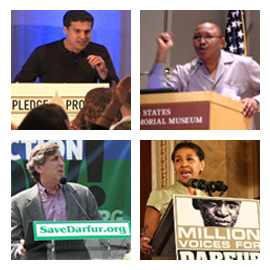Trackbacks
-
[…] The Promise of Engagement Investigating the past 6 years of Darfur policy and citizen advocacy Skip to content Bec HamiltonAuthor’s resumeAbout the projectAbout the interviewsUPCOMING PODCASTSSubmit a question « Questions for the advocacy community: Q2 – Eric Reeves […]
-
[…] wouldn’t be enough. For a more detailed description of some of the logistical challenges, see Bec Hamilton’s post describing some of these difficulties with regard to a no-fly zone in Darfur as it comes with […]









Questions for the advocacy community: Q2 – Eric Reeves
Q2: Is citizen advocacy at its most effective when it generates maximum “noise” on an issue , or do citizen advocates need to attach particular policy prescriptions to the noise they make?
Eric Reeves:
The value of advocacy “noise” per se varies as a crisis emerges; it is obviously most useful when there is simply no broader news or general international awareness. I remember a conversation with someone at USAID working on Darfur in late 2003; we simply couldn’t imagine how Darfur’s terrible realities had failed to galvanize not only a forceful US, European, and UN response, but widespread international outrage. She and I felt as though we were sharing a Cassandra-like dream, seeing all too clearly what was otherwise obscured from others, knowing all too well what was coming.
But of course Human Rights Watch, Amnesty International, and the International Crisis Group—among others—had offered terrifying accounts for many months. There was ample information in the public domain; it simply had not galvanized a widespread response. Certainly the Khartoum regime had counted on completing a (relatively) quick and invisible genocidal crushing of the Fur, Massaleit, and Zaghawa civilian base from which the rebel groups emerged. In many respects they succeeded.
But if “noise” was what was needed in 2003-early 2004, the developing Darfur advocacy movement should soon have moved to at least broad policy and diplomatic recommendations. “Noise” can always be answered by sympathetic rhetorical “noise” in return. And the advocacy movement should have committed itself, collectively, to a much greater understanding of the Darfur crisis and its place in the larger context of Sudan’s ongoing national trauma. A failure of understanding was the greatest shortcoming of the Save Darfur Coalition (SDC) under its previous administration, although this has been unfairly and tendentiously used by Mahmood Mamdani and others to represent the broader Darfur advocacy movement. SDC was also continually behind the advocacy curve; and in its excessively well-funded ignorance (especially in the form of high-profile newspaper ads) sometimes offended, even outraged humanitarian organizations, as well as some of its best-informed member organizations.
There are some telling examples. SDC missed opportunities to use its size and reach to support some of the advocacy initiatives that held real chances of changing the thinking not only in Khartoum, but in other national capitals as well. SDC was far too late in coming to support the Sudan divestment campaign, and far too late again in offering support to the “Genocide Olympics?” campaign. And yet it has cleaved to support for a “No Fly Zone” (NFZ) long after it was clear that this was one of the worst military responses to the actions by Khartoum and the Janjaweed in Darfur. A NFZ is transparently impracticable from a military point of view, provides no means of responding to Khartoum’s inevitable reprisals against humanitarians on the ground, and would quickly drive the regime to disguise all its Antonov military aircraft “UN white,” probably with UN markings. Flight paths involving humanitarian aircraft (which are also typically Antonovs) would deliberately be made confusing. Depending on the extent of the AWACS coverage, it would be extremely difficult to impossible to track very low-flying helicopter gunships over all of Darfur (and to distinguish them from humanitarian helicopters). And the expense would be exorbitant. Much more effective would be devotion of such resources to supporting the failing UNAMID, which—if fully outfitted with the helicopters and transport units it needs—could conceivably be much more effective in grounding Khartoum’s military aircraft through aggressive patrolling.
Inevitably there will be different policy and advocacy stances, even between well-informed constituents and advocacy groups. How to reach consensus, what to push hardest for, are the real questions of leadership. Perhaps consensus on particular advocacy efforts is not available, in which case complementarity is just as important. But “raising awareness” cannot substitute for broad advocacy policy commitments. If the Darfur advocacy efforts have been hobbled in North America, and in Europe to the extent it exists there, this has been largely in failing either to reach policy consensus or to devise effective strategies for complementing policy recommendations.
“Noise” alone can be effective for only a short time in the face of a catastrophe such as Darfur’s. The capacity for weak and feckless responses by the UN and Western democracies, and cynical or expedient responses by other international actors, should never be underestimated. Effective advocacy requires not only large numbers of supporters, but adequate knowledge and resourceful thinking about what to ask for. The latter has been too much missing.
Eric Reeves is the author of A Long Day’s Dying: Critical moments in the Darfur genocide. His articles on Sudan can be found at www.sudanreeves.org